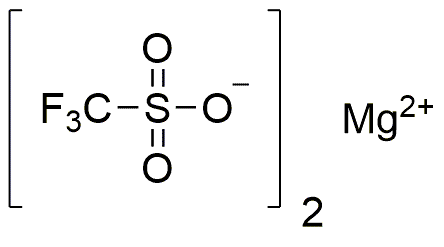Magnesium trifluoromethanesulfonate is widely utilized in research focused on:
- Catalysis: This compound serves as an efficient catalyst in various organic reactions, enhancing reaction rates and yields, particularly in the synthesis of fluorinated compounds.
- Electrolytes in Batteries: It is used as an electrolyte in lithium-ion batteries, improving conductivity and stability, which is crucial for energy storage applications in electric vehicles and portable electronics.
- Pharmaceuticals: The compound plays a role in drug formulation, particularly in the development of new medications that require specific ionic environments for stability and efficacy.
- Material Science: It is employed in the development of advanced materials, such as polymers and composites, where its unique properties can enhance strength and thermal stability.
- Environmental Applications: Magnesium trifluoromethanesulfonate is explored for use in water treatment processes, helping to remove contaminants and improve water quality.
General Information
Properties
Safety and Regulations
Applications
Magnesium trifluoromethanesulfonate is widely utilized in research focused on:
- Catalysis: This compound serves as an efficient catalyst in various organic reactions, enhancing reaction rates and yields, particularly in the synthesis of fluorinated compounds.
- Electrolytes in Batteries: It is used as an electrolyte in lithium-ion batteries, improving conductivity and stability, which is crucial for energy storage applications in electric vehicles and portable electronics.
- Pharmaceuticals: The compound plays a role in drug formulation, particularly in the development of new medications that require specific ionic environments for stability and efficacy.
- Material Science: It is employed in the development of advanced materials, such as polymers and composites, where its unique properties can enhance strength and thermal stability.
- Environmental Applications: Magnesium trifluoromethanesulfonate is explored for use in water treatment processes, helping to remove contaminants and improve water quality.
Documents
Safety Data Sheets (SDS)
The SDS provides comprehensive safety information on handling, storage, and disposal of the product.
Product Specification (PS)
The PS provides a comprehensive breakdown of the product’s properties, including chemical composition, physical state, purity, and storage requirements. It also details acceptable quality ranges and the product's intended applications.
Certificates of Analysis (COA)
Search for Certificates of Analysis (COA) by entering the products Lot Number. Lot and Batch Numbers can be found on a product’s label following the words ‘Lot’ or ‘Batch’.
Número de catálogo
Número de lote/lote
Certificates Of Origin (COO)
This COO confirms the country where the product was manufactured, and also details the materials and components used in it and whether it is derived from natural, synthetic, or other specific sources. This certificate may be required for customs, trade, and regulatory compliance.
Número de catálogo
Número de lote/lote
Safety Data Sheets (SDS)
The SDS provides comprehensive safety information on handling, storage, and disposal of the product.
DownloadProduct Specification (PS)
The PS provides a comprehensive breakdown of the product’s properties, including chemical composition, physical state, purity, and storage requirements. It also details acceptable quality ranges and the product's intended applications.
DownloadCertificates of Analysis (COA)
Search for Certificates of Analysis (COA) by entering the products Lot Number. Lot and Batch Numbers can be found on a product’s label following the words ‘Lot’ or ‘Batch’.
Número de catálogo
Número de lote/lote
Certificates Of Origin (COO)
This COO confirms the country where the product was manufactured, and also details the materials and components used in it and whether it is derived from natural, synthetic, or other specific sources. This certificate may be required for customs, trade, and regulatory compliance.


